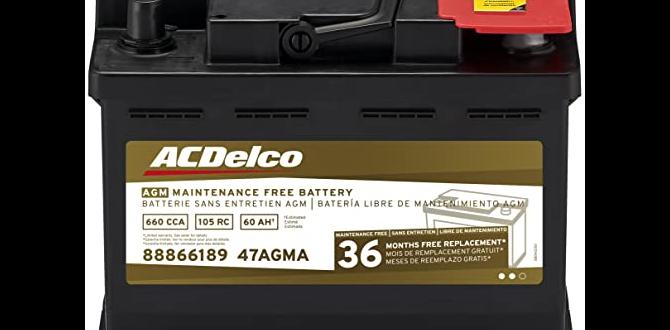What Size Battery For 2018 Chevy Silverado: Essential Guide
For your 2018 Chevy Silverado, the most common battery group size is Group 48 (H6). Always double-check your truck’s owner’s manual. Key specs include Cold Cranking Amps (CCA) and Reserve Capacity (RC). Choosing the right battery ensures reliable starting power, especially in cold weather.
Having your truck not start on a cold morning is frustrating, isn’t it? Especially when you’re in a hurry. Your 2018 Chevy Silverado relies on a strong battery to get going and power all its electronics. If it’s time for a replacement, or you’re just curious, figuring out the right battery size can seem a bit technical. Don’t worry, I’m here to make it simple. We’ll walk through exactly what you need to know, step by step, so you can get your Silverado back on the road with confidence. Let’s dive in!
Understanding Battery Basics for Your Silverado
Before we pinpoint the exact battery size for your 2018 Chevy Silverado, let’s touch on a few essential battery terms. Knowing these will help you make the best choice.
What is a Battery Group Size?
Battery group size is essentially a standardized measurement that tells you the physical dimensions of the battery, including its height, width, and length. It also indicates terminal placement and type. This standard helps ensure that a replacement battery will physically fit into the designated battery tray in your truck and that the cables will reach the terminals correctly.
Think of it like finding the right shoe size for your foot. If you get a size that’s too big or too small, it just won’t work. The same goes for car batteries; the group size needs to match the space available and the cable connections in your Silverado.
Cold Cranking Amps (CCA) and Reserve Capacity (RC)
Two other crucial numbers on a battery are Cold Cranking Amps (CCA) and Reserve Capacity (RC).
- Cold Cranking Amps (CCA): This measures how much power, or amps, the battery can deliver to start your engine when it’s very cold, typically at 0°F (-18°C). A higher CCA rating is better, especially if you live in a region with harsh winters. Your Silverado needs a certain level of CCA to turn over its engine reliably in frigid temperatures.
- Reserve Capacity (RC): This tells you how long the battery can provide power if your alternator fails. It’s measured in minutes, indicating how long accessories (like headlights, radio) can run on battery power alone before the battery dies. A higher RC means more backup power.
Types of Batteries
Most 2018 Chevy Silverado models will use lead-acid batteries. Within lead-acid, there are a couple of common technologies:
- Flooded Lead-Acid (FLA): These are the most traditional and often the most affordable. They require maintenance like checking fluid levels.
- Absorbent Glass Mat (AGM): These are more advanced and spill-proof. They offer better vibration resistance and can handle the higher demands of modern vehicles with more electronics and start-stop technology. Many newer trucks, including some Silverados, might benefit from or require AGM batteries for optimal performance and longevity.
Finding the Right Battery Size for Your 2018 Chevy Silverado
Now, let’s get down to the specific needs of your 2018 Chevy Silverado. While variations can exist based on engine size and specific trim options, there’s a primary group size that fits most.
The Most Common Battery Group Size: Group 48 (H6)
For the vast majority of 2018 Chevy Silverado trucks, the recommended battery group size is Group 48. This is also sometimes referred to as H6. Batteries in this group size are designed to fit the battery tray and accommodate the cable lengths found in your Silverado.
When you go to a parts store or look online, you’ll see batteries labeled as Group 48 or H6. These are interchangeable and refer to the same physical specifications.
Always Check Your Truck’s Owner’s Manual
While Group 48 (H6) is the most common, it’s absolutely crucial to confirm this information in your 2018 Chevy Silverado owner’s manual. This is the most reliable source for your specific vehicle’s requirements. Your manual will clearly state the recommended battery group size and often provides minimum CCA and RC recommendations.
If you don’t have your owner’s manual handy, you can usually find a digital copy on the Chevrolet website. This is a great resource for all things related to your truck.
Alternatives and Considerations
In some cases, especially with aftermarket modifications or if the original battery tray has been altered, you might find that other slightly different group sizes can fit. However, sticking to the manufacturer’s recommendation (Group 48/H6) is the safest and most reliable approach. Deviating without proper research could lead to fitment issues or electrical problems.
Factors that influence battery choice beyond size include:
- Engine Size: While Group 48 is common across many trims, larger engines might place slightly higher demands on the battery. The recommended CCA will reflect this.
- Climate: If you live in a very cold climate, you’ll want to prioritize a battery with a high CCA rating. For warmer climates, CCA is less critical than for extremely cold regions, but still important for reliable starts.
- Vehicle Usage: Do you do a lot of short trips or spend time with the engine off but accessories on? Consider a battery with a higher Reserve Capacity.
- AGM vs. Standard: As mentioned, many newer vehicles are designed to work best with AGM batteries due to their construction and ability to handle varied power demands. If your 2018 Silverado came with an AGM battery from the factory, it’s generally best to replace it with another AGM battery of the same size.
Recommended Specifications for 2018 Silverado Batteries
Beyond just the physical size, the performance specifications of the battery are critical for ensuring your 2018 Chevy Silverado starts reliably and powers its systems correctly.
Cold Cranking Amps (CCA) Recommendations
For a 2018 Chevy Silverado, the recommended CCA rating typically falls within a certain range. While the exact number can vary slightly depending on the engine type (e.g., 5.3L V8, 6.2L V8, 2.7L Turbo), general guidelines suggest:
Minimum Recommended CCA: Aim for a battery with at least 600-730 CCA. This range ensures sufficient power for reliable starts in most conditions, especially cooler temperatures.
If you live in an area where temperatures frequently drop below freezing, or if your truck has a larger engine, opting for a battery with a CCA rating at the higher end of this range (closer to 730 CCA or even slightly above) would be beneficial.
Reserve Capacity (RC) Recommendations
Reserve Capacity (RC) is important for how long your battery can power essential systems if the alternator isn’t working. For a 2018 Chevy Silverado, a good target for RC is:
Minimum Recommended RC: Look for a battery with at least 90-120 minutes of Reserve Capacity.
A higher RC is always a good thing, especially if you tend to run a lot of accessories while the engine is off, or if you want extra peace of mind in case of an unexpected electrical issue.
Why Battery Specifications Matter
Choosing a battery that meets or exceeds these specifications helps prevent common automotive problems.
Ensuring Reliable Starting
The primary job of your car battery is to provide the significant burst of power needed to crank the engine. Cold temperatures make this harder because cold oil is thicker, requiring more force (and therefore more electrical power) to turn the engine over. A battery with adequate CCA ensures your Silverado’s starter motor gets enough juice, even on the chilliest mornings.
Powering Electronics
Modern trucks like your 2018 Silverado are packed with electronics. From the infotainment system and navigation to power seats, heated mirrors, and advanced safety features, all these systems draw power. The battery plays a role in stabilizing this power and providing it when the engine isn’t running or when the alternator is under heavy load.
Preventing Electrical Issues
An underpowered or failing battery can sometimes lead to strange electrical issues. You might notice dim headlights, flickering dashboard lights, or even trouble with other electronic modules. Using a battery with the correct specifications helps prevent these symptoms by ensuring a consistent and sufficient power supply.
How to Check Your Current Battery
Before you head out to buy a new one, it’s a good idea to know what you currently have in your 2018 Chevy Silverado. This can provide confirmation, or alert you if something non-standard is installed.
Visual Inspection of the Battery Label
The easiest way to check is to locate your battery (usually under the hood, near the front) and look for its label. This label should clearly indicate:
- Group Size: Look for terms like “Group 48,” “H6,” or other group numbers.
- CCA Rating: You’ll see a number followed by “CCA.”
- RC Rating: Typically shown as “RC” followed by a number (in minutes).
- Brand and Model: The manufacturer’s name and the specific battery model.
Take a picture of the label with your phone if you can, so you have the information with you.
Consulting Service Records or Mechanic
If you have service records for your truck, they might indicate the battery that was last installed. Alternatively, your trusted mechanic or the service department at a dealership can tell you what battery is appropriate or what is currently installed if you’re unsure.
Choosing a Reputable Battery Brand and Model
When it comes to buying a new battery, there are many brands available. It’s wise to stick with well-known manufacturers that have a good reputation for quality and reliability.
Some Top Battery Brands Include:
While availability and specific models vary, here are some brands generally considered reliable for automotive batteries:
- DieHard: Known for durability and performance.
- Optima: Famous for their AGM spiral-cell technology, offering excellent vibration resistance and deep cycle capabilities.
- ACDelco: The official GM battery brand, ensuring compatibility and quality for your Silverado.
- Interstate Batteries: A widely recognized brand with a strong dealer network.
- Bosch: Offers a range of high-quality batteries, including advanced AGM options.
- Duralast (AutoZone): A popular choice with good warranties.
When selecting a battery, consider the warranty offered. Longer warranties often indicate the manufacturer’s confidence in their product’s longevity.
AGM vs. Traditional Battery Considerations for Your Silverado
As mentioned, many modern vehicles, including some configurations of the 2018 Silverado, are equipped with or benefit from AGM batteries. If your truck came with an AGM battery, it’s generally best to replace it with another AGM battery. These offer:
- Better performance under load: They can handle the demands of modern electronics and frequent starts/stops better.
- Longer lifespan: Typically last longer than traditional flooded batteries.
- Spill-proof design: Safer and more suitable for mounting in various positions.
However, AGM batteries are usually more expensive. If your Silverado came with a traditional flooded battery and doesn’t have start-stop technology or other high-demand features, a high-quality flooded battery that meets the CCA and RC specs can be a perfectly suitable and more budget-friendly option.
Installing a New Battery Yourself: A Step-by-Step Guide
Replacing a car battery is a task that many DIYers can handle with confidence, provided they follow safety precautions. Here’s how:
Safety First – Always!
Car batteries contain sulfuric acid and can produce flammable hydrogen gas. Taking the right precautions is paramount:
- Wear safety glasses: Protect your eyes from potential acid splashes or sparks.
- Wear gloves: Protect your skin from battery acid.
- Work in a well-ventilated area: Avoid enclosed spaces.
- No smoking or open flames: Keep sparks and flames away from the battery.
- Remove jewelry: Metal jewelry can create a short circuit.
- Be aware of short circuits: Never let a metal tool touch both battery terminals simultaneously.
Tools You’ll Need:
Gather these tools before you begin:
- New Battery (correct group size and specs for your 2018 Silverado)
- Wrench set (likely 10mm and 13mm) for terminal and hold-down clamps
- Battery terminal cleaner brush or wire brush
- Battery terminal protector spray or grease
- Gloves and safety glasses
- Optional: Pliers, anti-static mat
Step-by-Step Installation Process:
- Park and Power Down: Ensure your truck is parked on a level surface, the engine is off, and the parking brake is engaged. Turn off all accessories (lights, radio, etc.).
- Open the Hood: Locate the hood release inside your truck and open the hood.
- Locate the Battery: Identify the battery, usually towards the front of the engine bay.
- Disconnect the Cable – NEGATIVE FIRST: Using the appropriate wrench, loosen the nut on the negative (-) terminal clamp. Carefully remove the cable from the terminal. Make sure it doesn’t touch anything metal on the truck.
- Disconnect the Cable – POSITIVE SECOND: Now, loosen and remove the nut on the positive (+) terminal clamp. Remove the cable from the terminal.
- Remove the Battery Hold-Down Clamp: Batteries are secured by a clamp at the base or a bracket at the top. Loosen and remove the bolts or nuts holding this clamp in place. Keep track of these parts!
- Remove the Old Battery: Carefully lift the old battery straight up and out of the tray. Batteries are heavy, so use proper lifting technique and be mindful of your back. Place it somewhere safe and out of the way.
- Inspect and Clean the Tray and Cables: Clean any corrosion from the battery tray and the cable clamps. A battery terminal brush is ideal for this. Ensure the tray is free of debris.
- Install the New Battery: Carefully place the new battery into the tray, ensuring it’s oriented correctly with the positive and negative terminals in the right position.
- Secure the New Battery: Reinstall the battery hold-down clamp and tighten it snugly, but don’t overtighten. The battery should feel secure and not move.
- Reconnect the Cable – POSITIVE FIRST: Place the positive (+) cable clamp onto the positive (+) terminal of the new battery. Tighten the nut securely.
- Reconnect the Cable – NEGATIVE SECOND: Place the negative (-) cable clamp onto the negative (-) terminal. Tighten the nut securely.
- Apply Terminal Protection: Apply a thin layer of battery terminal protector spray or grease to the terminals and clamps to prevent corrosion.
- Final Check: Double-check



